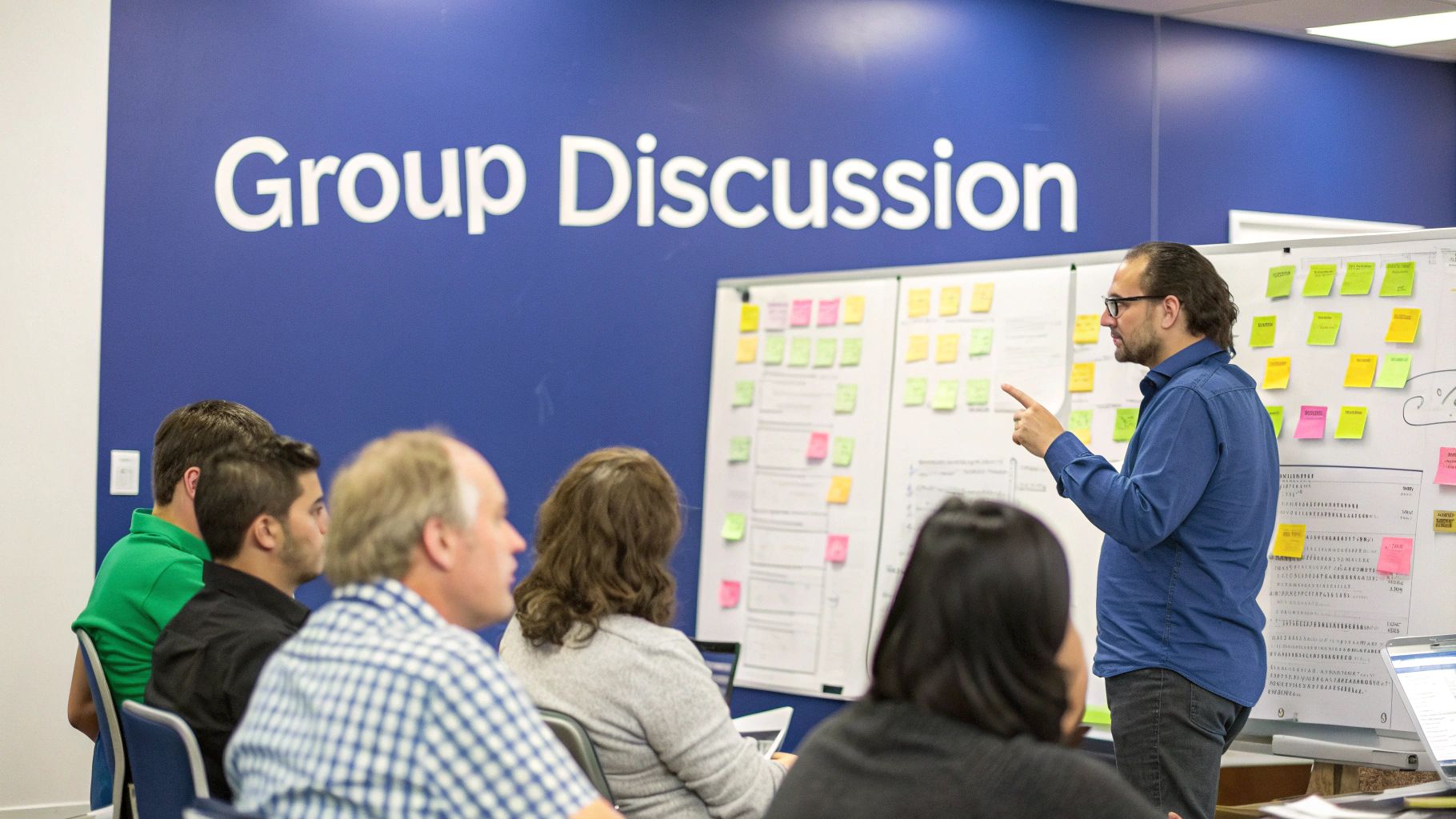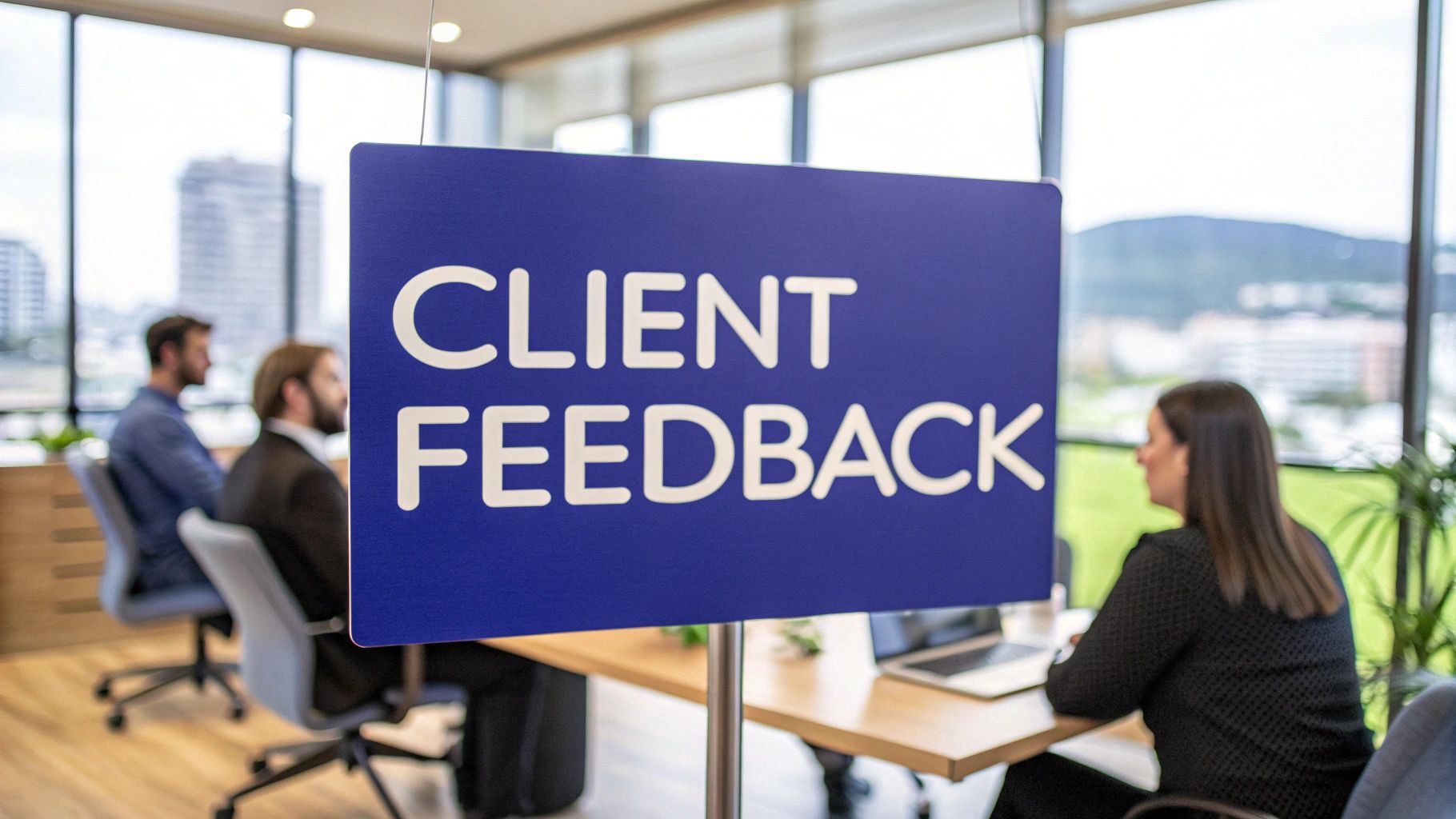Understanding The Power of Strategic Client Feedback

Client feedback forms the foundation of strong business growth. It gives you direct insight into what your customers experience, what they love, and where you can do better. For businesses aiming to stay competitive and grow, getting honest feedback from clients isn't optional – it's essential.
The Impact of Feedback on Business Growth
When clients share positive experiences, it does more than just validate your work. Their endorsements build trust with potential customers and inspire your team to maintain high standards. Just look at how reviews on Google influence purchase decisions.
Even negative feedback plays a vital role in improvement. Those complaints point out exactly where you need to focus to serve customers better. Research shows that when you resolve an issue well, customer loyalty increases by 25%. That's because clients appreciate businesses that listen and take action.
The numbers tell a clear story about feedback's importance. 13% of unhappy customers tell 15 or more people about bad experiences. And it takes 12 positive experiences to make up for one negative one that goes unresolved. Learn more about the impact of customer service in these detailed Customer Service Statistics.
Turning Feedback Into Actionable Insights
Collecting feedback is just the start. The real value comes from analyzing it to spot patterns and key themes you can act on. For instance, if several clients mention trouble with your website navigation, that's a clear signal to improve the user experience.
Make a plan to tackle the most impactful improvements first. Assign clear owners and timelines to ensure feedback drives real changes. Without this structure, valuable client input risks sitting unused instead of fueling progress.
Building a Feedback-Driven Culture
Creating a customer-centric culture means making client feedback central to how your team operates. Train staff to actively seek input, respond promptly to concerns, and celebrate wins. This builds a cycle where feedback constantly refines and improves the customer experience.
When you truly embrace client feedback as a guiding force, you gain advantages that help you outperform competitors and retain more customers. Taking this proactive approach ensures client perspectives actively shape your business decisions and direction.
Advanced Techniques for Gathering Actionable Insights

Getting useful feedback from clients takes more than basic surveys – it requires a thoughtful approach to gathering insights that drive real improvements. Smart companies use multiple methods to collect meaningful input at every customer touchpoint. Let's explore proven techniques that deliver results you can act on.
Designing Effective Feedback Systems
Building a great feedback system means creating an environment where clients feel comfortable sharing honest, detailed thoughts. High response rates are essential for getting a true picture of what your customers think. Make sure your approach matches your business goals and target audience. Want more tips? Check out How to get actionable feedback on your website.
Combining Traditional and Digital Approaches
The most successful companies blend tried-and-true methods like focus groups with modern digital tools. This multi-channel strategy creates a complete picture of the customer experience. For example, use online surveys for initial feedback, then follow up with phone interviews to dig deeper into key issues.
Identifying the Right Methods for Different Segments
Different customer groups respond better to different feedback methods. Know your audience and pick approaches that work for them. Young customers often prefer quick social media polls, while older clients may favor email surveys. Using the right method for each group leads to better quality feedback.
Overcoming Common Challenges in Feedback Gathering
Low response rates and unclear feedback are common hurdles. Making the process easy and offering incentives can boost participation. The analysis method matters too – techniques like sentiment analysis and word frequency analysis help turn raw feedback into clear action items. Learn more about analyzing customer feedback here.
Utilizing Technology for Enhanced Feedback Collection
The right tools make collecting and analyzing feedback much easier. BugSmash offers features like screenshot annotations and video feedback that help spot patterns quickly. Good tools create an ongoing feedback loop that drives constant improvement and builds stronger client relationships. Focus on platforms that save time while delivering clear, actionable insights.
Converting Raw Feedback Into Business Transformation

Getting feedback from clients is just step one. The real value emerges when you turn those comments and ideas into concrete business improvements. This process requires thoughtful organization, smart prioritization, and follow-through that creates measurable impact. Let's explore how successful companies make this transformation happen.
Frameworks for Categorizing and Prioritizing Feedback
Good organization is essential for spotting patterns and extracting useful insights. Here are proven approaches that work:
- Topic Categories: Sort feedback by areas like product features, support quality, pricing, and website experience. This highlights where changes are most needed.
- Impact vs Effort: Map feedback on a grid comparing potential benefits against required work. This helps identify quick wins that deliver big results – like making a small website change many clients requested.
- Sentiment Analysis: Use tools like BugSmash to evaluate if feedback is positive, negative or neutral. This reveals overall client satisfaction and urgent issues needing attention.
These frameworks add structure and prevent valuable client input from getting overlooked. Smart prioritization ensures you tackle changes that matter most.
Implementing Feedback-Driven Changes
Turning insights into real improvements needs a clear process. Focus on:
- Clear Action Items: Convert broad themes into specific tasks. For example, "make navigation better" becomes "add search bar" and "reorganize main menu."
- Clear Ownership: Assign specific people or teams to handle each task. This creates accountability and drives results.
- Realistic Deadlines: Set achievable timelines that maintain momentum without rushing quality.
- Progress Tracking: Use project tools to monitor task status and keep work moving forward. BugSmash helps centralize feedback and track implementation.
This structured approach ensures feedback creates real positive change. Even great input stays theoretical without proper implementation.
Creating Effective Feedback Loops
Lasting improvement needs ongoing feedback. Build strong feedback loops by:
- Regular Check-ins: Don't wait for problems. Set up continuous feedback through surveys, in-app forms, and social listening.
- Progress Updates: Tell clients how you're using their input. This shows you value their perspective and builds trust.
- Results Tracking: Monitor key metrics in areas you've improved based on feedback. This proves the program's value and reveals what to optimize next.
When clients see their feedback creating positive changes, they're more likely to keep sharing input. This powers a cycle of ongoing improvement driven by valuable client perspectives.
Creating a Customer-Obsessed Feedback Culture

To truly benefit from customer feedback, you need more than just collection methods – it must become part of your company's DNA. This means building a customer-obsessed feedback culture where everyone from leadership to frontline staff actively seeks out and acts on client input. When done right, feedback shifts from being a task to check off to a fundamental driver of business decisions.
Embedding Feedback Mechanisms at Every Level
Getting meaningful feedback requires making it effortless for customers to share their thoughts. Consider using tools like BugSmash to add feedback forms directly within your product experience. Train your customer-facing teams to naturally ask for input during conversations. The more touchpoints you create for feedback, the richer insights you'll gain about what's working and what needs improvement.
Training Teams for Professional Feedback Handling
Your teams need the right skills to handle feedback effectively. This includes training on how to professionally receive, categorize and respond to both praise and criticism. Set clear guidelines for turning negative feedback into constructive discussions. When teams see feedback as a tool for growth rather than criticism, it creates an environment where honest input is welcomed.
Transforming Criticism Into Opportunity
The best customer-focused companies don't run from criticism – they run toward it. Negative feedback points directly to gaps and opportunities for meaningful improvements. By embracing criticism openly, you create a cycle of continuous refinement driven by real customer needs.
Maintaining Enthusiasm for Continuous Improvement
Building this culture takes ongoing dedication. Share success stories that showcase how customer feedback led to positive changes. Recognize teams and individuals who effectively use feedback to drive improvements. When you celebrate feedback-driven wins, it reinforces the value of staying closely connected to customer needs. The companies that maintain this focus on customer feedback are the ones that build lasting loyalty and sustainable growth through deep understanding of their market.
Making the Most of AI in Client Feedback
Smart use of technology is transforming how companies understand and act on client feedback. Modern businesses are moving beyond basic surveys to create more meaningful conversations with customers. Artificial intelligence and machine learning are opening up exciting new possibilities for gathering actionable insights from client feedback.
Smart Analysis of Client Sentiment
One of the most powerful AI applications is sentiment analysis. This technology can quickly categorize feedback as positive, negative, or neutral, giving teams an instant pulse check on client satisfaction. AI can process thousands of reviews in minutes, spotting important patterns that would take ages to find manually. This helps companies catch and fix problems early.
Getting More Personal with Feedback Requests
AI makes it possible to tailor feedback requests to each client's preferences. By looking at when and how clients interact with your business, AI helps time and phrase requests in ways that get better response rates. This personal touch makes clients more likely to share honest, detailed feedback.
Smooth and Simple Feedback Collection
Modern tools can automatically gather feedback across email, social media, and chat channels. The system then sends responses to the right team members for quick action. This removes manual work and helps teams respond faster to client needs. Quick responses lead directly to happier clients.
Blending AI With Human Understanding
While AI is powerful, human insight remains essential. The best feedback systems combine AI's processing power with human empathy and judgment. For example, while AI spots negative feedback, humans excel at understanding context and crafting thoughtful responses. Together, AI and human teams create better client experiences.
Finding Your Perfect Tech Solution
Many tools can help you harness AI for better feedback. Platforms like BugSmash offer features like screenshot annotations and video feedback that make sharing thoughts easy and visual. When picking tools, look for ones that work smoothly with your current systems and are easy for everyone to use. The right technology should fit naturally into your workflow while helping you better understand and serve your clients. Quality feedback systems build stronger client relationships and drive real business growth.
Measuring Success and Maximizing ROI
Success in client feedback programs requires more than just collecting responses – you need to demonstrate real business value and return on investment to justify ongoing support. This means establishing clear metrics, setting benchmarks, and creating reports that show tangible improvements in your bottom line.
Key Performance Indicators (KPIs) for Feedback Programs
The right metrics help quantify your feedback program's impact and reveal areas needing attention. Learn more about critical metrics in 5 Client Feedback Metrics That Drive Results.
- Customer Satisfaction (CSAT) Score: Measures overall satisfaction with your offerings through scaled survey responses. Higher scores indicate better customer experiences.
- Net Promoter Score (NPS): Tracks customer loyalty and likelihood to recommend. Identifies enthusiastic promoters and detractors of your brand.
- Customer Effort Score (CES): Evaluates how easily customers can accomplish tasks and find information. Lower scores mean less friction.
- Customer Retention Rate: Shows what percentage of customers continue doing business with you. Strong feedback programs help reduce churn by addressing pain points.
- Conversion Rate: Tracks prospects who become paying customers. Using feedback to align with customer needs improves conversion.
Developing Meaningful Benchmarks
Set clear performance targets to measure your progress. For example, if your CSAT is currently 60%, aim to reach 70% within six months. Research industry standards for metrics like NPS and work to exceed them.
Creating Compelling ROI Reports
Show stakeholders the business impact by connecting feedback data to key outcomes:
- Increased Revenue: Document how feedback-driven changes boost sales and customer lifetime value
- Reduced Costs: Calculate savings from fewer support tickets, returns, and operational expenses
- Improved Efficiency: Demonstrate faster processes and better workflows based on customer input
Link these improvements directly to your bottom line to prove the value of investing in feedback.
Optimization and Continuous Improvement
Keep refining your feedback program based on results. Regularly review KPIs, spot opportunities, and adjust your approach. This might mean trying new collection methods, implementing tools like BugSmash, or updating how you handle feedback internally. Stay focused on your goals while being willing to adapt.
Ready to start gathering more valuable client insights? BugSmash helps you collect and act on feedback effectively.




